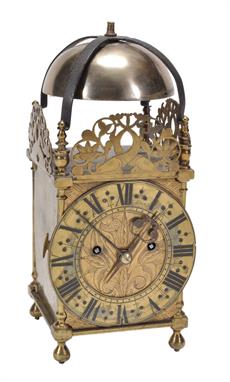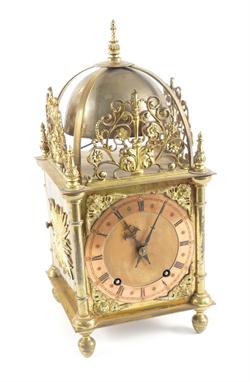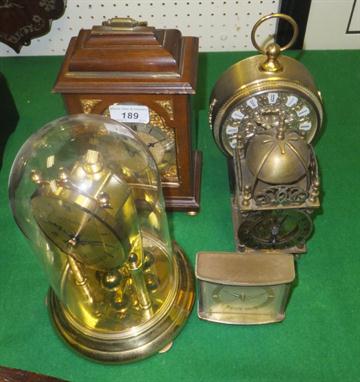We found 4372 price guide item(s) matching your search
There are 4372 lots that match your search criteria. Subscribe now to get instant access to the full price guide service.
Click here to subscribe- List
- Grid
-
4372 item(s)/page
An unusual George III small spring driven alarm timepiece John Monkhouse, London, circa 1760 The five pillar single chain fusee movement with verge escapement and alarm mounted behind the dial sounding on a bell mounted above, the plates measuring 4.25 high and 3 inches wide and applied with dust shutters to top and sides, the single sheet silvered Roman numeral dial measuring approximately 5.25 inches by 3 inches with alarm disc to centre and blued steel hands within chapter ring with Arabic five minutes to outer track, within foliate strapwork engraved spandrels and signed J.n.o. Monkhouse, London to the ogee outline arch above, now mounted on a cavetto moulded mahogany base, 15cm (6ins) high. John Monkhouse is recorded in Baillie, G.H. Watchmakers & Clockmakers of the World as working in London 1756-71. From the evidence of his surviving work, which includes several quarter chiming and musical longcase clocks as well as a miniature grande-sonnerie longcase clock, he was a fine and inventive maker. The current lot was probably designed as a travelling timepiece (a spring-driven alternative to a miniature weight-driven lantern alarm timepiece), and was probably originally supplied with a fitted wooden case for protection whilst in transit.
A Victorian brass lantern clock Unsigned, late 19th century The four pillar single chain fusee movement with anchor escapement and passing hour strike on a bell mounted within the domed bell bearer above the frame, the brass dial with foliate engraved centre and applied Roman numeral chapter ring with fleur-de-lys half hour markers, the frame with ball feet, columnar uprights and urn finials flanking dolphin frets, with brass side doors and backplate, 38cm (15ins) high.
A Victorian brass lantern clock Jump, London, late 19th century incorporating earlier elements The four pillar twin chain fusee movement with anchor escapement and striking the hours on a bell mounted within the domed bell bearer above the frame, the backplate with pendulum holdfast and signed Jump, London, the brass dial with foliate engraved centre and applied Roman numeral chapter ring with bold fleur-de-lys half hour markers, the frame with ball feet, columnar uprights and urn finials flanking dolphin frets beneath unusual iron bell bearer, with brass side doors and backplate, 33cm (13ins) high. The current lot was probably put together by the firm of Joseph and Henry Jump who are recorded in Loomes, Brian Watchmakers & Clockmakers of the World, Volume 2 as working in London 1875-81. The Jump family were fine makers who succeeded the Vulliamy family, and are perhaps best known for their complex shagreen covered tombstone-shaped carriage clocks.
A William III brass lantern clock James Gray, Shaston (Shaftesbury), circa 1695 The posted bell striking movement with verge escapement and pendulum swinging outside the frame to the rear, the dial signed James Gray Shaston above unusual engraved decoration with large tulip buds issuing from a twin scroll handled planter, with pierced brass hand within applied Roman numeral chapter ring with stylised trident half hour markers and with leafy infill to angles, the frame with one-piece column turned corner posts beneath dolphin engraved and pierced frets, integral vase turned finials and domed bell bearer, with hanging hoop to rear and on ball feet, (lacking side doors and backplate), 38cm (15ins) high; with an oak and brass wall bracket with female mask and scroll cast supports. James Gray of Shaftesbury in Dorset is recorded in Loomes, Brian LANTERN CLOCKS & Their Makers as working around the turn of the 18th century. Loomes illustrates a similar example to the current lot (page 203 fig. 12.25) and notes that the integral pillar castings, brass hand and primitive but bold `flowers in a vase` engraved decoration to dial centre indicate a Bristol influence, with the engraving perhaps being a naive interpretation of decoration seen on examples by John London. The example illustrated by Loomes differs from the current lot in that it has an anchor escapement, sword-hilt half hour markers to the chapter ring and lion and unicorn pattern fets. These differences suggest that the current lot is a little earlier than the one illustrated in Loomes, indeed the trident half hour markers in particular are much more akin to 17th century practice, hence it is probably safe to suggest that the current lot predates 1700. A third example, which is almost identical to the current lot, is illustrated in Hana, W.F.J. English Lantern Clocks page 88 (plate 42) where it is wrongly identified as a `lantern clock made in Scotland`.
A fine and well documented William and Mary brass lantern clock Thomas Veale, Chew Magna, dated (16)92 The posted countwheel bell-striking movement with verge escapement and short bob pendulum swinging outside the frame to the rear, the dial with central vestigial alarm disc concealing an area of practice engraving with initials TV above 92 and further inscribed Clean`d Feb. 19, `3, `94 within symmetrical foliate tulip engraved infill and with pierced brass hand within applied Roman numeral chapter ring with stylised fleur-de-lys half hour markers, the angles engraved with bands of concentric brickwork, the `Bristol` frame with one-piece column turned corner posts beneath lion and unicorn armorial engraved and pierced frets, integral multi-knopped tall vase-and-cover turned finials and domed bell bearer, with brass side doors, iron backplate and hanging hoop above spurs to rear, on tall disc-knopped ball feet, 40cm (15.75ins) high. Thomas Veale`s dates are collated in Loomes Brian Lantern Clocks & Their Makers page 307 where it is noted that; - `Bellchambers records his freedom at Bristol in 1652. Moore records him as being of Bristol in 1660 when he was a bondsman to a marriage. George White records his marriage at Chew Magna 1656 to Charity Plaister. He was working to at least 1697. He left sons John and James, but no clocks are yet recorded by them`. The current lot utilises frame castings that were favoured by the Chew Valley school of clockmakers with the earliest surviving dated example made by Edward Webb of Chew Stoke in 1676 (private collection). Several other clocks by Webb are known with dates ranging from 1678-93, with all of the documented examples sharing the same frame castings. These castings were also used by Edward Bilbie of Chew Stoke (who is believed to have succeeded Edward Webb in around 1695) for his earlier lantern clocks, long after Bristol makers had tended to opt for castings more closely related to London work of the period. The on-going use of this pattern of frame suggests that they were cast locally, perhaps initially by Edward Webb at his foundry in Chew Stoke (which was just over a mile from Thomas Veale`s home at Denny Farm, Chew Magna), then by the Bilbie family after Webb`s death in 1694. Of Thomas Veale five lantern clocks are documented, with all but one dated and made within the timespan 1692-7. All these examples share the same basic frame castings and are signed with the initials TV either behind the alarm disc or chapter ring. These examples can be found and compared in the following sources; White, George English Lantern Clocks page 230 fig. V/35 (undated example), page 231 figs. V/36 (the current lot) and V/38 (dated `97 -detail of dial only). Bruce, Bill and Hooper, John EARLY ENGLISH LANTERN CLOCKS 1615-1700 page 50 (dated 1692). Darken, Jeff and Hooper John English 30 Hour Clocks page 92 figs. 2/66 and 2/67 (dated `95). All of the four dated examples share similar engraving executed with scrolling foliage issuing from a central point at the base of the dial centre, continuing symmetrically around the alarm disc and terminating with a central flowerhead motif at the top. The angles are decorated with the same concentric brickwork infill. The undated example (White, George English Lantern Clocks page 230 fig. V/35) departs a little from the above similarities by incorporating larger more abstract scroll-work towards the lower margin of the dial centre and terminates with a female mask at twelve o`clock. It is perhaps interesting to compare this example with those made by Edward Webb during the 1680`s which tend exhibit the same basic design within the engraving; which was strongly influenced by the work of Thomas Brown of Bristol during the 1650`s (see White, George English Lantern Clocks page 232). From this observation it would be perhaps reasonable to suggest that the undated example is probably the earliest surviving example of his work and may pre-date 1680. The current lot also exhibits an unusual insight into clock ownership during the 17th century. The dial centre is inscribed clean`d Feb.19, `3, `94 indicating that it was common practice at this time to send a clock back to the maker for cleaning on an annual basis. This detail adds yet further interest to what is a fine and original well documented example of a 17th century Chew Valley lantern clock.
A Fine Charles II brass lantern clock Thomas Wheeler, London, circa 1685 The posted countwheel bell-striking movement now converted to anchor escapement with long pendulum, the dial engraved with continuous band of scrolling flowering tulip foliage around vacant centre formerly fitted with an alarm disc, with original iron hand and applied Roman numeral chapter ring with stylised fleur-de-lys half hour markers and leafy infill to angles, the standard London third period `Lothbury` frame with column turned corner posts beneath engraved and pierced dolphin pattern frets signed Tho: Wheeler neare ye french Church to lower front margin between vase turned finials and with domed bell bearer above, the sides with original plain brass side doors, on turned ball feet, (alarm removed), 40cm (15.75ins) high; with a later oak wall bracket. Provenance: Purchased by the vendor from Philips Fine Art Auctioneers in 1978 having belonged to the former owner for around 40 years. Illustrated in Cescinky, Herbert & Webster, Malcolm R. English Domestic clocks page 61 (fig. 36) where it is described as being in the possession of Percival Griffiths Esq. Thomas Wheeler is recorded in Loomes, Brian LANTERN CLOCKS & Their Makers as apprenticed in 1648 to Nicholas Coxeter and gaining his freedom of the Clockmakers` Company in 1656. He became Assistant from 1674, Warden from 1680 and was appointed Master in 1684. His last record of attendance was in 1694 and is thought to have died between 1695 and 1701, when his widow received charity from the Company. The introduction of the verge escapement with short bob pendulum to lantern clocks presented difficulties to makers with regards to the positioning of the alarm mechanism. Traditionally, on balance wheel clocks, the alarm was placed to the rear on the outside of the backplate. However on a pendulum clock this position is likely to conflict with the preferred position of the pendulum. One solution to the problem was to relocate the pendulum within the frame, either at the rear or between the trains in the centre of the movement; with latter being the option preferred by many London makers during the 1680`s including John Ebsworth, Richard Ames as well as Thomas Wheeler. Another option was to relocate the alarm within the frame to the rear, this solution was preferred by West Country makers such as Edward Webb of Chew Stoke. The current lot, however, takes a novel approach with alarm being originally mounted halfway through the backplate, with the pulley positioned within the frame (holes for the lines to exit are still visible in the bottom plate) and the crownwheel and hammer assembly positioned outside. The alarm would have been fitted on a pivot post fitted to a curved iron bridge which would have been riveted to the backplate. The current lot has a relatively early and neat conversion to anchor escapement but with an unusually large escape wheel of 52 teeth, pallets spanning 12 teeth, and pendulum with effective length of 46.5 inches. This layout results in a pendulum beating slower than a standard seconds period pendulum and with very small amplitude. The most logical reason for this unusual arrangement is that the clock was to be housed in a tall narrow `longcase` at the time of conversion, this would also probably account for the hanging hoop and spurs being removed at that time.
A William and Mary brass lantern clock With signatures for both Thomas Colpeas, and John Maer, Richmond, circa 1690 The posted countwheel bell-striking movement with verge escapement and pendulum swinging within the frame of the clock between the trains, the dial engraved with script Tho: Colpeas towards the upper margin of the dial centre and with flowering tulip scrolling infill beneath, the centre with alarm disc and original iron hand within applied Roman numeral chapter ring with stylised fleur-de-lys half hour markers and engraved John Maer, Richmond to lower edge, the standard London third period `Lothbury` frame with column turned corner posts beneath foliate engraved and pierced frets, vase turned finials and domed bell bearer, the sides with plain brass side doors, the rear with iron hanging hoop and spurs fitted to the iron backplate, on turned ball feet, (alarm removed), 39.5cm (15.5ins) high. The current lot is an almost textbook example of a `third period` London made lantern clock with classic `Lothbury` pattern frame and pendulum swinging between the trains. Both signatures, however, do not appear to be recorded as makers working in the London area at this time. Thomas Colpeas is apparently unrecorded and a John Ma(y)ers is recorded in Loomes, Brian Watchmakers & Clockmakers of the World, Volume 2 as working in Richmond, Yorkshire, circa 1770. The most likely explanation for the probable discrepancies with these names is that the current lot was possibly bought-in/ordered from a London maker for retail locally (Yorkshire perhaps) by Thomas Colpeas in around 1690 (see White, George English Lantern Clocks page 204). The clock could have been subsequently acquired by John Ma(y)ers who may have had his signature added before selling it on.
English Second Period Lantern Clock, Peter Closon An English Second Period Lantern Clock, c. 1650, marked "Peter Closon, Londini Fecit", strapped striking bell, over finials and dolphin frets, dial plate with foliate engraving, the alarm disk with flat-top "8" and J-form "1s", converted to double fusee pendulum movement, height 15 in., width 6 in., depth 6 in. Provenance: Purchased August 16, 1984, Austin Appraisal Service
A Victorian lantern clock the eight-day duration, double fusee movement striking the hours on a bell set within the top straps, the brass dial with an engraved centre of floral decoration, with the raised chapter ring engraved with black Roman numerals and decorative half-hour markings, and with blued steel hands (one broken), the case with turned pillars to the four corners and surmounted by a further finial, height 36cm.
Japanese traditional lantern alarm clock , the brass case of square section with side doors, top bell and exposed balance beams for long and short day/night hours, the silvered dial composed of an inner alarm set disc, and a chapter ring inscribed 4 - 9 in Japanese twice on the inner register for the six variable hours of day and night, and their corresponding zodiacal symbol on the outer register, over two apertures of cardinal and zodiacal symbols, the triple weight movement with a double crown wheel and single crown wheel and foliot movement striking the hour, raised on its hardwood stand, lantern height 26cm, overall height 89cm (ticks, strikes, rings).*See clocks and watches proviso.
An early 18c lantern clock by William Jackson of Loughborough (Loomes lists him circa 1730/40), in brass lantern case with dolphin frets and bell above. The silvered chapter ring has a single hand and the dial centre is signed. The 30 hour movement has a verge escapement (the verge shaft and crown wheel have been renewed but the old ones are in the case) and the movement is countwheel striking on the bell. The case has its hoop and spikes for hanging and rope drive and weight, the clock 15.5" tall overall.
-
4372 item(s)/page
























































